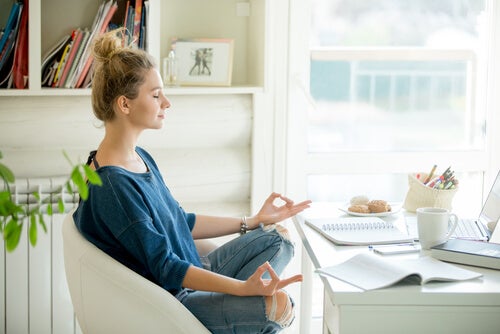How to Find Time to Meditate

If the hustle and bustle and the obligations of everyday life don’t allow you to practice relaxation techniques, read this article. We’ll tell you how you can do it through small daily actions. Finding time to meditate is easier than you think.
It’s often quite difficult to adjust your routines to temporarily accommodate the myriad of activities that you face every day. In fact, many people proudly proclaim that they’re too busy to do the things they should and want to do.
The same goes for meditation. Establishing a meditation routine can be pretty difficult. However, as meditation can promote a healthy body and mind, then reason alone may be compelling enough to set aside time for this practice on a daily basis.
In fact, a study conducted by the University of California confirms that the benefits of meditation can remain with us for years.
If you have time to breathe, you probably have time to meditate.
Here are some keys to finding time to meditate that will help you stop procrastinating. Are you ready?

1. Finding time to meditate: prioritize your activities and goals
When you’re looking to make meditation a regular habit, it’s important to prioritize the most important things in your life.
If you’re having trouble figuring out where you can find time to include a daily meditation session, then examine your current schedule objectively. Try to spot areas where you can cut back on activities that are at the bottom of your priority list.
Family, work, and personal responsibilities will always demand your time. However, it’s always possible to find the right time to meditate if you prioritize things and if you’re willing to make small changes to your schedule.
2. Wake up 10 minutes earlier
You probably fight for every extra minute you can stay in bed. However, if you swap that time in bed for time to meditate, you’ll have a better day.
Try waking up 10 minutes earlier and settle down to meditate. It’s a good investment!
For many people, the best time for meditation is right after they wake up. Why not leave your phone to the side and start your morning with meditation? Just do this for five minutes and you’ll see the difference. Once this becomes part of your routine, you’ll be using your time more productively.
“Do you have the patience to wait till your mud settles and the water is clear? Can you remain unmoving till the right action arises by itself?”
-Lao Tzu-
3. Find breaks between activities
To synchronize with your natural rhythm, find times and breaks between each activity in your day, whether it’s between tasks at work, after cooking, or before you start eating.
Use those transition times to close your eyes and take between three and five natural, relaxed breaths whenever you can. Even a few minutes can be enough to reduce stress.
You can do this anywhere, whether it’s at your desk or in the bathroom. Anywhere you choose! The more you practice it, the more it’ll become a natural response to overcoming stressful situations.
4. Focus on your breathing
If you’re still convinced that you’re too busy to sit down and meditate, then try this trick: focus on your breathing. Next time you’re alone on a train, washing dishes, cleaning your house, or even in the shower, try tuning into your inner space by focusing on your breathing.
Quiet yourself as much as you can to be able to fully listen to your breathing.

Finally, remember that there are many opportunities to practice meditation and mindfulness throughout the day. To find time to meditate, all you have to do is plan, commit yourself to self-care, and be content to take a break from time to time.
If the hustle and bustle and the obligations of everyday life don’t allow you to practice relaxation techniques, read this article. We’ll tell you how you can do it through small daily actions. Finding time to meditate is easier than you think.
It’s often quite difficult to adjust your routines to temporarily accommodate the myriad of activities that you face every day. In fact, many people proudly proclaim that they’re too busy to do the things they should and want to do.
The same goes for meditation. Establishing a meditation routine can be pretty difficult. However, as meditation can promote a healthy body and mind, then reason alone may be compelling enough to set aside time for this practice on a daily basis.
In fact, a study conducted by the University of California confirms that the benefits of meditation can remain with us for years.
If you have time to breathe, you probably have time to meditate.
Here are some keys to finding time to meditate that will help you stop procrastinating. Are you ready?

1. Finding time to meditate: prioritize your activities and goals
When you’re looking to make meditation a regular habit, it’s important to prioritize the most important things in your life.
If you’re having trouble figuring out where you can find time to include a daily meditation session, then examine your current schedule objectively. Try to spot areas where you can cut back on activities that are at the bottom of your priority list.
Family, work, and personal responsibilities will always demand your time. However, it’s always possible to find the right time to meditate if you prioritize things and if you’re willing to make small changes to your schedule.
2. Wake up 10 minutes earlier
You probably fight for every extra minute you can stay in bed. However, if you swap that time in bed for time to meditate, you’ll have a better day.
Try waking up 10 minutes earlier and settle down to meditate. It’s a good investment!
For many people, the best time for meditation is right after they wake up. Why not leave your phone to the side and start your morning with meditation? Just do this for five minutes and you’ll see the difference. Once this becomes part of your routine, you’ll be using your time more productively.
“Do you have the patience to wait till your mud settles and the water is clear? Can you remain unmoving till the right action arises by itself?”
-Lao Tzu-
3. Find breaks between activities
To synchronize with your natural rhythm, find times and breaks between each activity in your day, whether it’s between tasks at work, after cooking, or before you start eating.
Use those transition times to close your eyes and take between three and five natural, relaxed breaths whenever you can. Even a few minutes can be enough to reduce stress.
You can do this anywhere, whether it’s at your desk or in the bathroom. Anywhere you choose! The more you practice it, the more it’ll become a natural response to overcoming stressful situations.
4. Focus on your breathing
If you’re still convinced that you’re too busy to sit down and meditate, then try this trick: focus on your breathing. Next time you’re alone on a train, washing dishes, cleaning your house, or even in the shower, try tuning into your inner space by focusing on your breathing.
Quiet yourself as much as you can to be able to fully listen to your breathing.

Finally, remember that there are many opportunities to practice meditation and mindfulness throughout the day. To find time to meditate, all you have to do is plan, commit yourself to self-care, and be content to take a break from time to time.
This text is provided for informational purposes only and does not replace consultation with a professional. If in doubt, consult your specialist.







